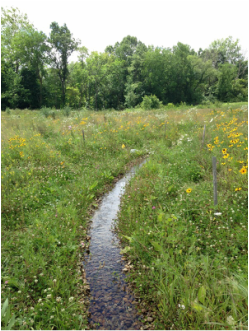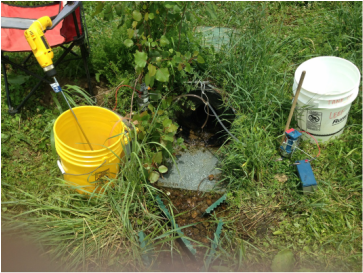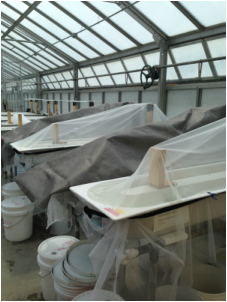arial shogren
Contact: [email protected]
Twitter: @ArialShogren
Twitter: @ArialShogren
| Shogren CV 2016 | |
| File Size: | 136 kb |
| File Type: | docx |
PhD Candidate
Summer 2013 - Present
Research Interests:
Summer 2013 - Present
Research Interests:
- Environmental DNA (eDNA) and fine particle transport in flowing water
- Invasive species management via environmental DNA detection
- Effects of emergent contaminant presence on ecosystem function
Current Projects
1. Modeling the effect of substrate on the transport of eDNA using flow-through column experiments
Method:
Method:
- Detecting environmental DNA (eDNA) in water can determine the presence of rare or invasive aquatic species and is similar in application to the forensic use of trace DNA left at crime scenes.
- While eDNA detection methods have great potential for monitoring aquatic species, there is a lack of understanding of how biological and physical conditions in flowing waters influence eDNA detection.
- Using experiments conducted in continuous flow-through columns, we filled knowledge gaps on how eDNA is transported in stream beds and whether substrate type and the presence of biofilms influences the retention of eDNA.
2. Quantifying the effect of substrate structure and heterogeneity on the fluvial transport of fish eDNA using Notre Dame's Linked Ecosystem Experimental Facility (ND LEEF)
Problem:
While a globally growing problem, the Great Lakes Region alone spends an aggregate $100 million on prevention, management, and eradication of invasive fishes annually. This is an expensive problem, in addition to the environmental issues associated with invasion. The increasing use of environmental DNA detection techniques has been useful as a proactive monitoring tool for invasive species in susceptible waterways. However, much of the field research on fish eDNA has been done in lentic (ponds & lakes) or mesocosms, and therefore it is currently not well understood how eDNA is transported and retained in flowing (i.e., stream and river) systems.
Objective:
Problem:
While a globally growing problem, the Great Lakes Region alone spends an aggregate $100 million on prevention, management, and eradication of invasive fishes annually. This is an expensive problem, in addition to the environmental issues associated with invasion. The increasing use of environmental DNA detection techniques has been useful as a proactive monitoring tool for invasive species in susceptible waterways. However, much of the field research on fish eDNA has been done in lentic (ponds & lakes) or mesocosms, and therefore it is currently not well understood how eDNA is transported and retained in flowing (i.e., stream and river) systems.
Objective:
- While eDNA is a useful tool for monitoring, eDNA is not a “typical” particle. It is a heterogeneous, non-uniform particle, with may sources and sizes, complicating how we interpret it in a flowing environment.
- One end goal of eDNA techniques is to estimate location and densities of populations of organisms upstream of a collection site. Studies have shown that eDNA is in fact transported long distances downstream at varying velocities.
- We asked: how is eDNA transported and retained in flowing water, particularly focusing on the influence of benthic substrate. Our goal was to estimate eDNA retention in four contrasting experimental streams.
3. Monitoring the dispersal of environmental DNA using Light Transmission Spectroscopy (LTS)
Problem:
Prevention of species invasion is key. Managers need sampling tools and protocols that are designed to rapidly detect invasive species with high levels of certainty, low cost, and minimum stress for organisms.
Objective:
- To use a novel detection method (Light Transmission Spectroscopy - LTS) on LEEF samples, comparing to the standard quantitative PCR (qPCR) technique used on eDNA samples.
Light Transmission Spectroscopy (LTS)
- Light-based detection technique using nanobeads in suspension.
- PCR amplification not necessary for detection, saving time.
- Potential to be quantitative.
- Field-ready, instantaneous results on laptop. Fits in small suitcase.
4. Determining the influence of substrate heterogeneity on particle transport using ND LEEF
The decomposition of large leaves breaking down into finer particles fuels in-stream processes. These particles are known to episodically deposit and re-suspend during downstream transport, resulting in temporary retention. Particle behavior is complex: they are not permanently retained along a stream reach, but can alternately “stick” on substrate, and then be re-released and continue saltations downstream.
Problem:
Particles can be transported many meters downstream from their origin, which connects upstream to downstream reaches. To date, all fine particles are often considered to be transported similarly in the environment. In real environments, however, particles may span a wide range of sizes that yay influence their transport.
Objective:
The decomposition of large leaves breaking down into finer particles fuels in-stream processes. These particles are known to episodically deposit and re-suspend during downstream transport, resulting in temporary retention. Particle behavior is complex: they are not permanently retained along a stream reach, but can alternately “stick” on substrate, and then be re-released and continue saltations downstream.
Problem:
Particles can be transported many meters downstream from their origin, which connects upstream to downstream reaches. To date, all fine particles are often considered to be transported similarly in the environment. In real environments, however, particles may span a wide range of sizes that yay influence their transport.
Objective:
- Using pulse releases of particles of differing diameter, we hoped to improve understanding of in-stream retention of particles of varying sizes, focusing on the exchange between water and benthic storage that influence retention (i.e. substrate).
5. Investigating eDNA degradation and instream retention using artificial streams
Problem:
One goal of eDNA techniques is to estimate species abundance or timing of presence from a downstream sample. However, it is not yet understood what factors influence eDNA degradation in flowing systems.
Objective:
Problem:
One goal of eDNA techniques is to estimate species abundance or timing of presence from a downstream sample. However, it is not yet understood what factors influence eDNA degradation in flowing systems.
Objective:
- Using artificial streams, we investigated the impacts of: light, velocity, disturbance, and biofilm on eDNA presence in the water column.
- To use particle analogs (e.g., micro plastic beads, pollen, yeast) to understand how particles are retained and resuspended during a flow disturbance event.





